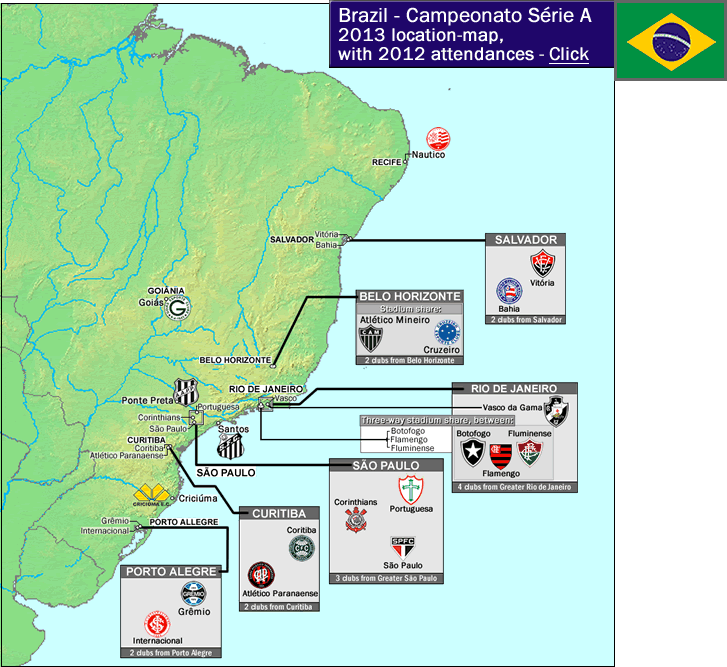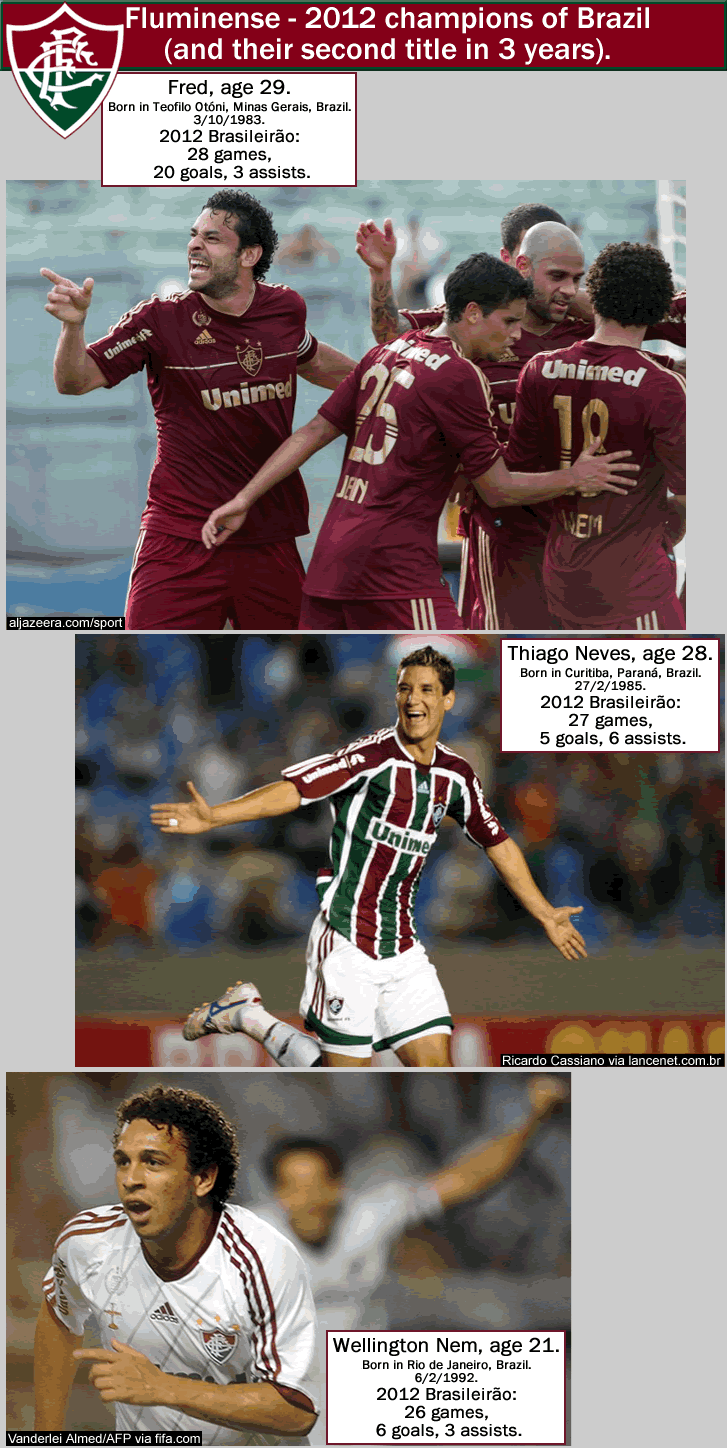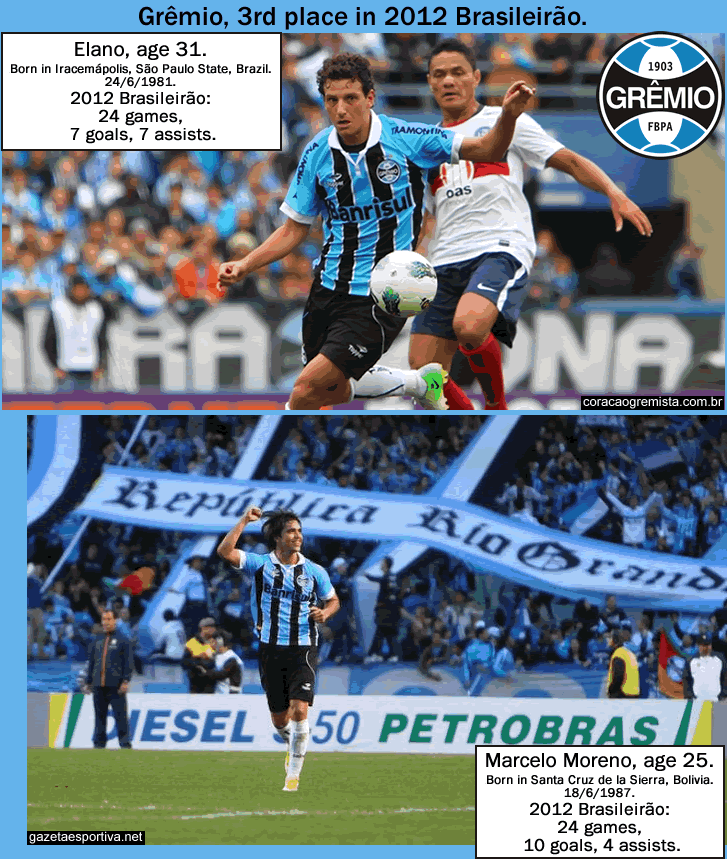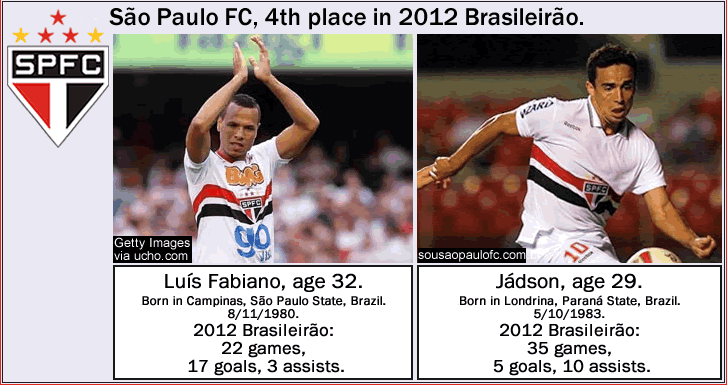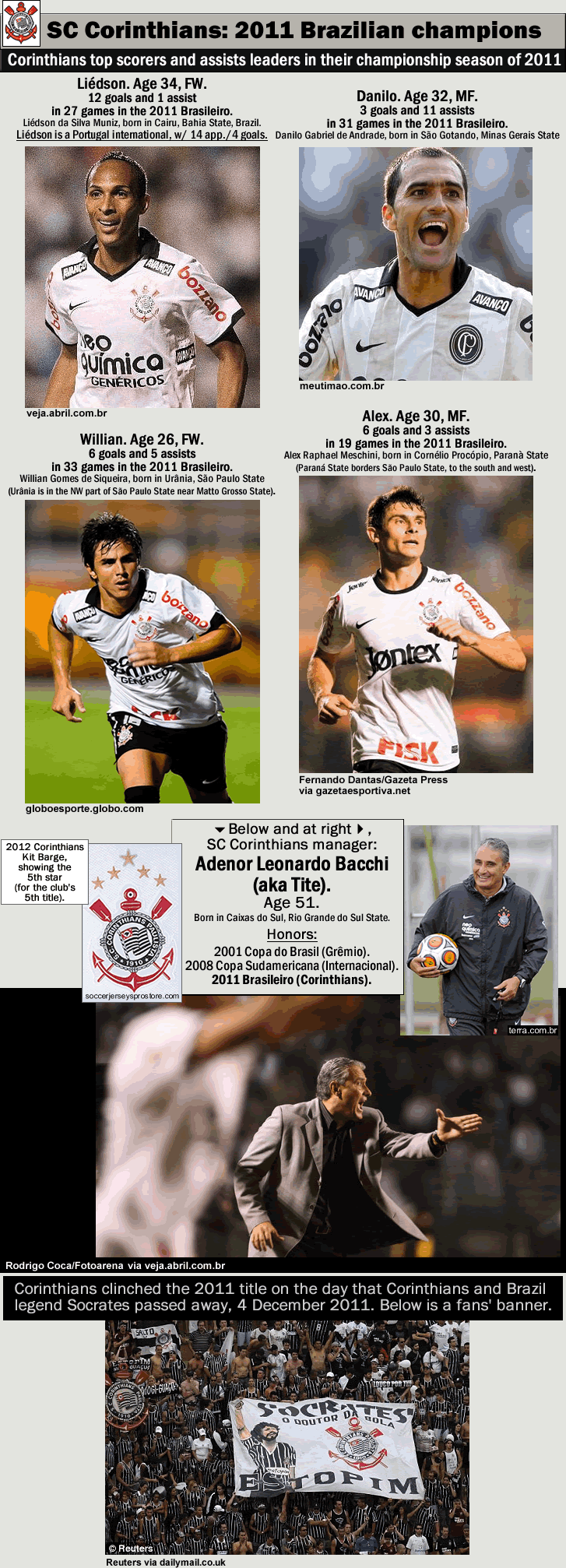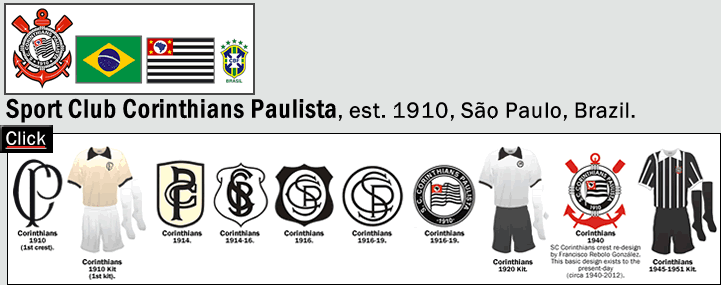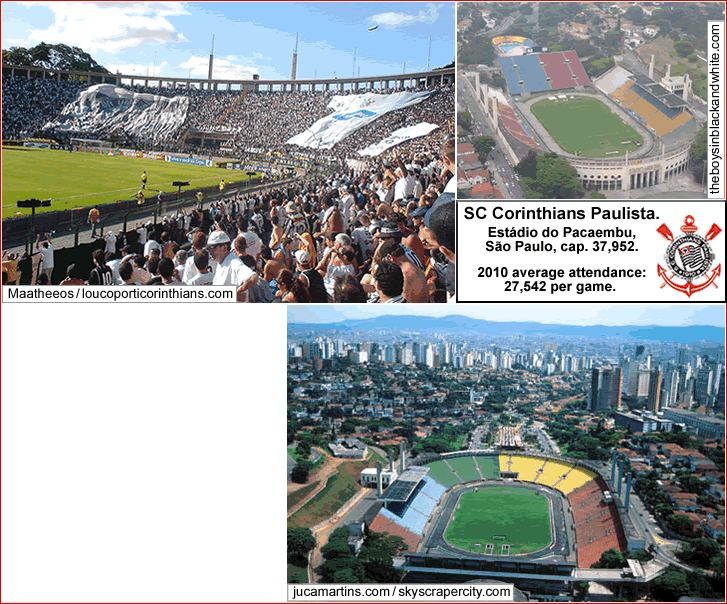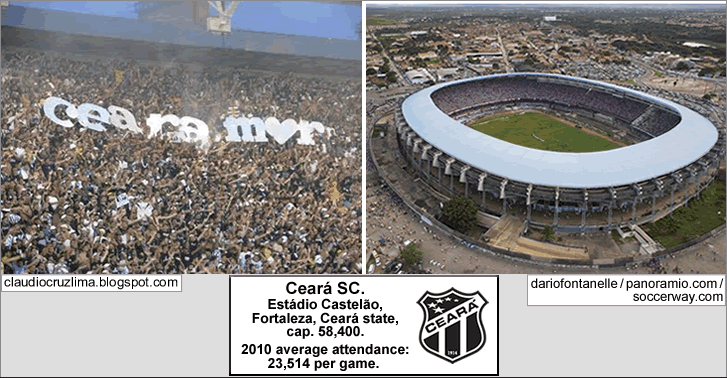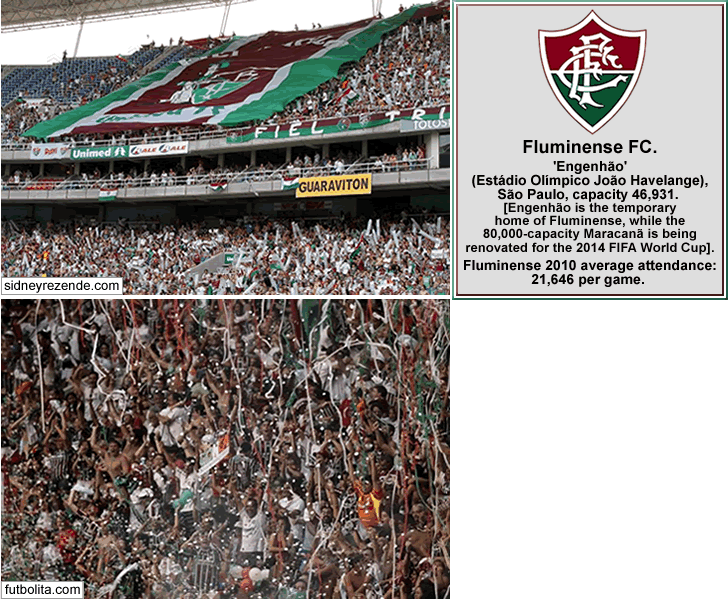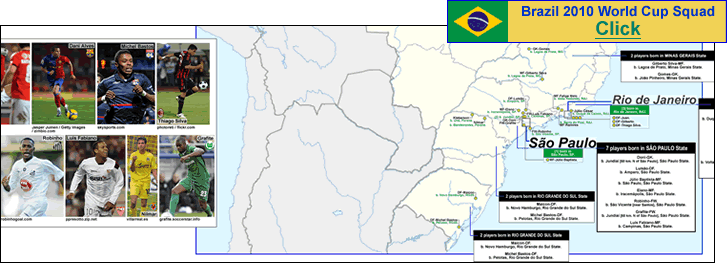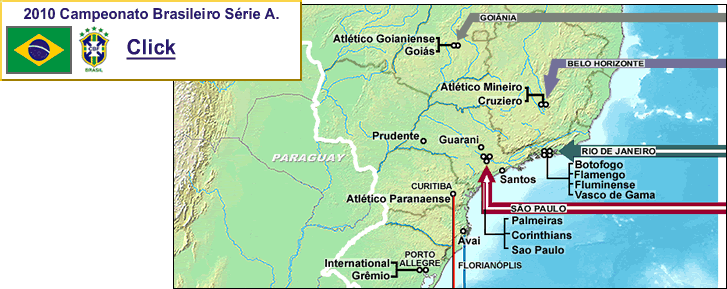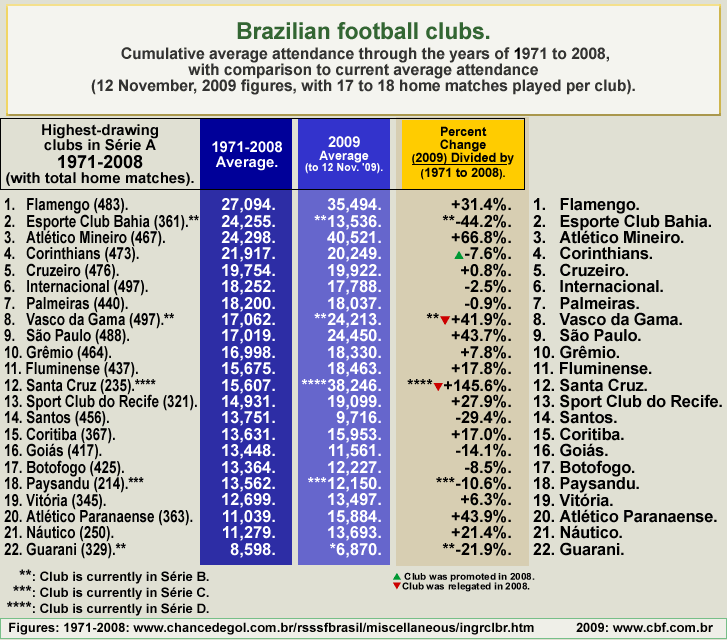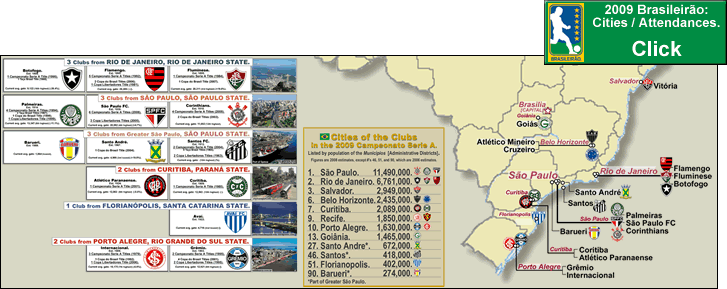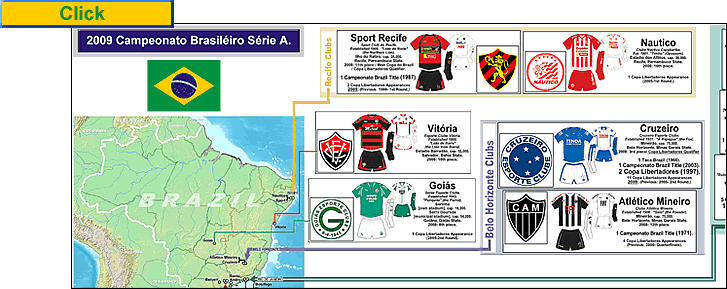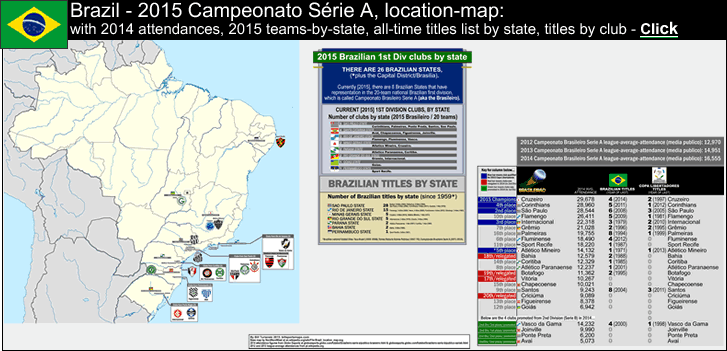
2015 Campeonato Brasileiro Série A location map
…
…
…
Links…
-Teams…2015 Campeonato Brasileiro Série A.
-Tabela…http://globoesporte.globo.com/futebol/brasileirao-serie-a/.
-Scores, fixtures, table… http://www.flashscores.co.uk/football/brazil/serie-a/.
-Blog on Brazilian football, which is run by one of the contributors to billsportsmaps.com, James Nalton…http://thebotafogostar.com/.
…
- Brazil – 2015 Série A location map: with 2014 attendance, 2015 teams-by-state, all-time titles-by-state & titles by club
By Bill Turianski on 29 May 2015; twitter.com/billsportsmaps.com.
On the map page…
The left-hand side of the map page features a simple location-map of the 2015 version of the confusingly-named Campeonato Brasileiro Série A (it is easier to just refer to the competition as the Brasileiro).
In the center of the map page is a two-part chart which shows representation in the 2015 Brasileiro by state, with a list below that which shows the all-time list of Brasileiro titles by state. (Note: there are 28 States in Brazil, plus a Federal District [Brasilia]. 8 of those states have representation in the 2015 Brasileiro, with Sao Paulo state, as usual, having the most teams in it – 5 teams, and, with, surprisingly, the small-but-relatively-wealthy southern state of Santa Catarina having the second-most teams in it – 4 teams. [Rio de Janeiro state only has 3 teams in the 2015 Brasileiro, because Botofogo was relegated in 2014]).
At the right-hand side of the map page is a chart which shows 24 clubs (the 20 from last season and the 4 promoted up from Série B for the 2015 season), and it features 4 bits of information…
1). How the clubs finished in 2014 and if they are playing in the Copa Libertadores or the Copa Sudamericana for 2015.
2). The 24 clubs’ 2014 average attendances (from domestic league matches/ paid-tickets+free-tickets counted [aka publico]).
3). Brasileiro titles (incl. previous Brazilian national titles, from 1959-1970/1971-2014), with year of last title noted.
4). Copa Libertadores titles, with year of last title noted.
Poor attendance plagues Brazilian pro football…
Brazilian first division attendance – league-wide – has increased by slightly more than 3,500 per game in two years. 2012 was the modern-day low-point of crowd-size in Brazilian pro football, when the Brazilian first division averaged a paltry 12,970 per game (paid attendance; publico attendance was 13 per game higher at 12,983; seen here at sidebar there). In 2013, the league-average increased (by 15.2 percent) to 14,951 per game. Last season [2014], aided by the continued introduction of several new or renovated stadiums (some of which were built or were renovated for the 2014 FIFA World Cup), attendance increased again (by 10.7 percent) to 16,555 per game.
There is little doubt that the quality-level of Brazilian top flight football has eroded over the past decade. The fact that more fans are now in attendance – a 27.6 percent increase in 2 years – is a good sign. But the stadiums that host Brazilian first division matches are very dangerous places, and large sections of the sporting-fan-public have made the conscious decision to stay away from the stadiums, stay home, watch football on TV, and be safe. According to Brazilian media giant Globo, 23 people died in 2012 at Brasileiro games; and in 2013, 30 died {see this article, Why Brazil’s footballers play to half-empty stadiums (guardiam.com/football by Jonathan Watts on 25 Feb. 2014)}.
-See this, Soccer’s Deadliest Fans: The Troubled World of Brazil’s ‘Organizadas’ (rollingstone.com by James Young on 28 May 2014).
-See this, article 5 facts about Brazil’s soccer hooligans (by Daniel Milan at Matador network from 9 June 2014);
that last article, linked to above, points out 5 salient points about fan violence in Brazilian pro football…
1. Problems typically unfold outside the stadiums.
2. Different sets of hooligans can team up.
3. Players aren’t immune.
4. It’s a super homophobic scene.
5. They really like Carnaval.
Brazilian pro football is a colossal mess, with all the best Brazilian players leaving as soon as they can, for the moneyed clubs in Europe, or for anywhere else, for that matter {see this, Brazilian clubs in crisis as wages unpaid and debts rocket (insideworldfootball.com by Ricardo Seaton on 23 November 2014)}. The clubs there in Brazil often literally have nothing…they usually don’t own their stadiums, and they usually don’t even own the full transfer-rights to most of their best players (thanks to the insidious rise of third-party-ownership). As to TPO (third party ownership), measures look to be implemented which will impose more restrictions on the practice. As James Young points out in the article linked to at the end of this paragraph, “In the short term, a ban on third-party ownership is likely to create serious cash-flow issues for financially strapped Brazilian clubs, which frequently rely on the sale of percentages of their promising young players to third parties just to pay the bills. In the longer term, however, the move may be a positive step since it forces clubs to stir from their collective torpor and encourages much-needed reform of the underperforming domestic game, which is plagued by financial woes, low attendance and an archaic fixture calendar.”…{excerpt from
Brazilian football faces battle to emerge from third-party ownership (espnfc.us by James Young on 8 Oct. 2014)}.
Brazil has won the most FIFA World Cup titles of any nation (5 WC titles), but there are 14 other pro leagues in the football world that currently [2014] outdraw Brazil’s first division…
Brazil’s first division is only the 13th-highest drawing in the world, and fourteenth highest if you count all leagues (see next sentence). Using 2013-14 figures, here are the countries in the world whose top flight in football (aka soccer aka association football) outdraws Brazil’s top flight (note: the second division in Germany, 2-Bundesliga, also outdraws Brazil’s top flight).
1). Germany
2). England (incl. Wales)
3). Spain
4). India [Indian Super League]
5). Italy
6). Mexico
7). Argentina
8). France
9). Netherlands
10). USA/Canada
11). China
12). Germany, 2nd division (2-Bundesliga)
13). Japan
14). Brazil
{Source – List of attendance figures at domestic professional sports leagues (en.wikipedia.org).}
Empty stadiums in Brazil…
Very few people in Brazil really actually go to 1st division matches – I mean, the first divisions in China and in USA/Canada both outdraw Brazil’s first division. And those two leagues (MLS & China’s 1st division) both pretty much suck. The fact that the talent-poor/ rigged-by-its-single-entity-ownership-system/ closed-shop-Union-busting-cartel known as Major League Soccer outdraws Brazil’s first division should tell you all you really need to know about the sad state of professional Brazilian football. (In 2014 MLS drew 19.1 K per game, 2.6 K more than Brazil’s Série A.) The fact that the spectacularly talent-poor and ersatz Chinese Super League outdraws Brazil’s first division is just more salt on the wound. (In 2013-14, the Chinese Super League drew 18.9 K per game, 2.4 K more than Brazil’s Série A.)
{Sources of 2014 league-wide attendance data,
O público do Brasileirão-2014 (globoesporte.globo.com/futebol)
Major League Soccer/attendance/Season averages (en.wikipedia.org)
2014 Chinese Super League (en.wikipedia.org)}
-
Brazil deserved to be humiliated by Germany (7-1), because Brazilian football is a goon-show run by corrupt clowns
Last June [2014], the Brazil national team embarrassed themselves in front of the whole world, on their own home turf. They lost by the score of 7-1 to Germany. It was a so-very-public humiliation, and it was well deserved, and it was a long time coming. In the aftermath of that brilliant German demolition, the following comment, made on an article on the 7-1 mauling that is linked to further below, sums it all up quite nicely…
“…Delighted for Brazil. They got exactly what they deserved. From the first game against Croatia when it was delicately poised at 1-1, a Brazilian theatrical dive results in a penalty. Neymar scores. Brazil win 3-1. They then carried on kicking and gouging their way to the finish line hoping it would be enough because Neymar will provide. Scolari’s a thug tactician. The Colombian game was meant to be a blugeoning warm up excercise for this game. David Luiz was sent out on the pitch every game with the specific instructions to elbow and tackle from behind after the ball’s gone etc. Yes he scored a great free kick against Colombia, but lucky as hell. He’s missed about 100 of those for Chelsea. Tonight he elbowed a player deliberately at 0-0. And they were all at it. Hulk is one of the most selfish stuck up players there is. A team of mercenary thugs playing as a loosely held together rag tag bunch, missing it’s two lynchpins Silva and Neymar. Rough-housing, cheating, bullying and in the end ruthless, efficient pragmatism and no little skill sensationally obliterated them. This is a watershed moment in terms of a match result…” (comment by Russell at {rte.ie/sport/soccer/worldcup/germany-hammer-hosts-brazil-to-advance}).
Losing 7-to-1 to Germany…that is your new legacy, Brazil. The beautiful game has passed you by, Brazil. David Luiz, aka Capitulator-in-chief-to-the-German-onslaught…that is your new symbol, Brazil. David Luiz, now of petro-dollar club PSG. David Luiz, who is flashy and ridiculous to look at, and who is a dirty hack and goon of a player and who is way too expensive…and who is also fundamentally incompetent. {See this, Meet soccer’s most expensive loser (nypost.com by Cameron Tomarchio on 8 July 2014).}
David Luiz pretty much sums up your whole act, Brazil national team. Flashy, expensive, and incompetent goons playing for a directionless giant republic, with no plan and no clue whatsoever. As Tony Jimenez points out in the article linked to below…”This is a player [Luiz] that Gary Neville…described as performing as though he was a player being controlled by a 10-year-old kid on a Playstation.”…”If it wasn’t for his gimmick hairstyle, I highly doubt that he [Luiz] would be turning out in the upper echelons of European football, much less leading out his country at a World Cup finals – and that he is able to strut about so arrogantly, blaming everyone else for his mistakes, and pocketing a small fortune, is more fool us.”…{excerpts from Why Calamitous David Luiz Represents Football’s Conman Economy (huffingtonpost.co.uk by Tony Jimenez on 20 July 2014).}
The Brazilian football team’s only plan is to play like goons (Brazil had the most fouls of any team in the 2014 WC), then cry when another team responds to their goonish behavior with the same. After Colombia mauled Neymar in response to the goon-show that was Brazil-2014, some saw the sweet payback coming (see this, Brazil’s goonish tactics won’t work against Germany at World Cup (latimes.com by Kevin Baxter on 7 July 2014)}.
The Brazilian football authorities have SOLD THE SELECTION OF THE NATIONAL TEAM TO SPONSORS!…
And selections for the Brazil national team are not even based on choosing the best players. No, Brazil chooses the most marketable players. You think I am making this up? Well check out this: Leaked contract reveals how national federation auctioned the Brazilian National Team. from that link, “…
[Criteria for selecting Brazil national team squad members]…
-The list of players called must match criteria established by commercial partners. Any change on the squad must have the consent of the companies involved.
-When a player is replaced, the one to get in his place must have the same marketing value.
-The contract is held between CBF (the brazillian national football federation) and a private company called Internacional Sports Events, a company with zero employees and no headquarters, located in the Cayman Islands.
-The ten years contract gives ISE exclusive rights to manage the team’s games and ownership of all transmission rights.
-The contract states that the top players, considered part of the main team, must start every single match, with no space for newcomers whatsoever, until they have a proper “marketing value”.
-The responsible for this contract is Ricardo Teixeira, former president of CBF and son-in-law of Joao Havelange. Teixeira and Havelange received more than 40 million dollars worth of bribes from marketing agency ISL, which collapsed into bankruptcy in 2001.
The sport we love is very sick, my friends.”…{end of excerpt at http://us.reddit.com/r/soccer/comments/368jm0/leaked_contract_reveals_how_national_federation/ [posted by conffra]}.
A similar story has recently been reported by the Brazilian newspaper Estadão, here, Report: Marketing Firm Owns Rights To Select Brazil National Team Squad (screamer.deadspin.com article from 18 May 2015 by Billy Haisley).
You have no answers, Brazil, and you still have a bunch of corrupt old-white-folks running your show and standing in the way and blocking progress and stuffing their pockets while the beautiful game and the nation of Brazil itself withers on the vine. Brazil has now sold the selection of its national team squad to outside interests. In other words, Brazilian football has sold its soul to the devil. Brazilian football is run by corrupt clowns.
And the geniuses who run the Brazil national team found a pretty lame “solution” to that 7-1 humiliation. Their “solution” was to re-hire the goon they had as coach before (Dunga). Seven-to-One, and the solution is to re-hire the last-goon-in-charge.
And the Brazilian pro league is hamstrung by its actual calendar (a May to December season), because Brazil lets all those corrupt old-white-guys keep their sweet gigs, which are useless, as the corrupt old-white-guys run the pointless state leagues, which act in a parasitic way on the game, sucking the lifeblood out of Brazilian pro football, while playing pointless and fundamentally stupid state championships in February and March and April. Come the August transfer window, squads in Brazil are often thrown into disarray. {See this, Historical Brazil state championships a drag on rest on of league season (espnfc.us by James Young on 24 March 2015).}
The useless empty stadiums Brazil built for the 2014 World Cup…
Reporting from Natal, Brazil, from 18 May 2014, by Paulo Prada, Brazilians left wanting by flawed World Cup investments (reuters.com).
For the World Cup they hosted, Brazil spent a mint (~$11 billion) – building useless 2014 WC venues, in places they never should have built 2014 WC venues. Venues that will now always remain empty, such as the one smack in the middle of the Amazon in Manaus, which doesn’t even have a third-division club. It now sits empty and under-utilized.
Then there is the stadium Brazil built for the 2014 World Cup in a city of just 550,000 [Cuiabá], whose highest-placed club is in the third division. It now sits empty and under-utilized.
Then there is the stadium Brazil built for the 2014 World Cup in Natal, which has never had a first division club and whose highest-drawing clubs can’t even draw 4 K (homeless people were recently found living in the dressing rooms there). It now sits empty and under-utilized.
They (the-old-white-folks-in-charge) spent and lined their pockets on instantly-useless White Elephants, while millions and millions of Brazilians still live in favela shacks and have no way to get to work – because they spent all the public-transportation money on stupid stadiums that no one will use now. They spent the whole wad on instantly-useless stadiums where there are no teams to fill the stadiums now, instead of spending those billions of dollars on absolutely-needed public improvement projects (see second link below for the 4 biggest White Elephants Brazil built for the 2014 WC, three of which I just mentioned above).
-See this, World Cup leaves Brazil with bus depots and empty stadiums (bbc.com/sport/football by Bruce Douglass on 29 March 2015).
-See this, The Four Biggest Stadium Boondoggles Of Brazil’s World Cup (thinkprogress.org by Travis Waldron on 14 July 2014).

Photo credit above – Jefferson Bernardes at latimes.com
Then there’s the Petrobras scandal, which is a kickback conspiracy involving building those useless stadiums and government big-shots and the largest corporation in the whole country. In relation to the Petrobras scandal, the treasurer of the administration of the Brazilian president was recently arrested.
-{See this, In Brazil, arrest brings Petrobras scandal closer to President Rousseff (LA Times.com, by Vincent Blevins on 15 April 2015)}.
-{See this, Brazil Builder Collapse Jeopardizes World Cup Stadiums (bloomberg.com by by Tariq Panja on 31 March 2015).}
-{See this, Brazil’s Slumping Economy and Bribery Scandal Eat Away at Dilma Rousseff’s Popularity (nytimes.com by Simon Romero on 25 March 2015).}
But Brazil has a solution to one of those problems…it looks like the authorities have figured out how to make that White Elephant in Manaus pay off…”there has been talk that the government might convert it into a jail, and given the issues around Brazil’s law enforcement, perhaps that’s not a legacy a sporting event should aspire to leave behind.”…{quote from The Four Biggest Stadium Boondoggles Of Brazil’s World Cup (thinkprogress.org by Travis Waldron on 14 July 2014)}.
What a joke.
___
Thanks to all at the following links…
-Brasileiro league average attendance and team-by-team 2014 attendances (Serie A and Serie B) can be found at the links below….
Thanks to Globo Esporte/futebol for Brazilian first division attendance figures (público), http://globoesporte.globo.com/futebol/brasileirao-serie-a/publico-brasileirao.html; and second division attendance figures, http://globoesporte.globo.com/futebol/brasileirao-serie-b/publico-serieb.html.
Thanks to NordNordWest at File:Brazil location map.svg, for blank map of Brazil.
Thanks to the contributors at 2015 Campeonato Brasileiro Série A (en.wikipedia.org).

